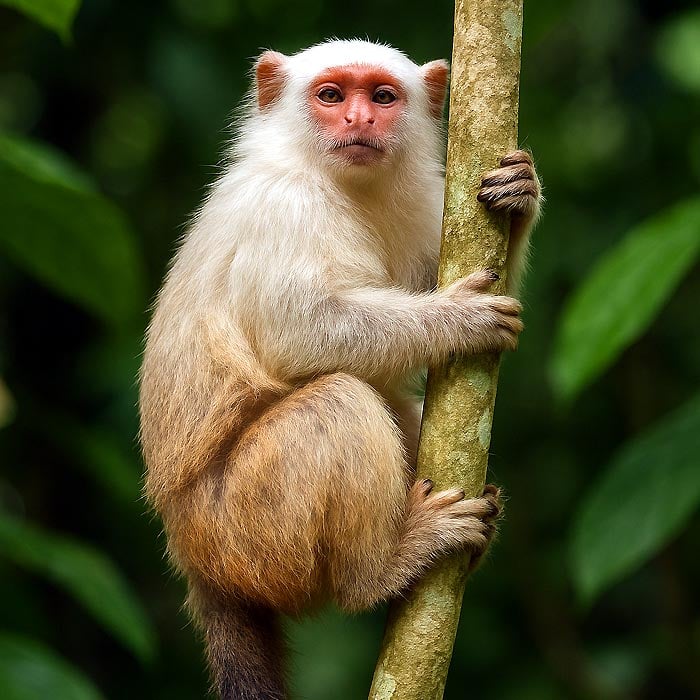
| Animalia | Primates | Callitrichidae | Mico | Mico schneideri |
Schneider’s marmoset (Mico schneideri) is a recently described species of Amazonian primate, only formally recognized by science in 2021. Endemic to a restricted region in the southern Amazon, this small monkey inhabits the arc of deforestation in Mato Grosso State, Brazil, an area experiencing rapid environmental change.
Table of Contents
The species was long confused with other marmosets due to similarities in appearance; however, advances in morphological and genetic research revealed its distinctiveness, leading to its formal description.
The discovery of Mico schneideri underscores both the rich biodiversity of the Amazon and the knowledge gaps that remain, even in well-studied animal groups like primates. However, its habitat is under severe threat from deforestation, primarily driven by agricultural expansion and cattle ranching.
As a result, the species is already classified as Endangered, with both its population and habitat in decline.
Schneider’s Marmoset Distribution
Schneider’s Marmoset Characteristics

Schneider’s marmoset is a small New-World Monkey belonging to the family Callitrichidae.
- Like other types of monkeys in the genus Mico, it is characterized by a diminutive body size, claw-like nails (tegulaeWhat is tegulae?The term tegulae refer to the hardened, hairless skin pads found on parts of their hands or feet—especially where the digits bend. These pads improve grip and tactile sensitivity, helping monkeys grasp branches securely during climbing and movement through trees.) instead of flat nails on most digits, and a long tail.
- The species was distinguished from its close relatives through a combination of morphological features and genetic data, forming a distinct clade with no evidence of overlap with other marmoset species in its region.
The fur coloration and unique patterns of the Schneider’s marmoset set it apart from similar species. However, earlier taxonomic confusion arose because these differences are subtle and variable. The species is allopatric, meaning its distribution does not overlap with that of other Mico species, and it exhibits unique morphological traits that can be used for identification.
Schneider’s Marmoset Habitat
Schneider’s marmoset is endemic to the Amazonian forests within the deforestation arc in Mato Grosso State, Brazil.
- Its range is geographically bounded by the Juruena River to the west and the Teles Pires River to the east, extending north to their confluence.
- The southern boundary is less well-defined but does not extend south of the city of Lucas do Rio Verde.
- The species inhabits subtropical and tropical moist lowland forests, which are considered suitable and essential for its survival.
Unfortunately, this region is experiencing some of the highest rates of deforestation in the Amazon.
- From 2001 to 2020, Mato Grosso State lost 21% of its forest cover. Within the marmoset’s range, studies estimate a historical loss of 42% of habitat between 1997 and 2017.
- Projections suggest that, if current trends continue, up to 86% of the species’ habitat could be lost in the coming decades due to agriculture, cattle ranching, and infrastructure development.
What Do Schneider’s Marmosets Eat?
Schneider’s marmoset is an omnivore. Its diet consists mainly of fruits, flowers, and insects. The species spends most of its time in the forest canopy foraging for these foods. By eating fruit and flowers, Schneider’s marmoset acts as a seed disperser in its ecosystem. Eating insects may also provide an ecological benefit by acting as an antiparasite for trees.
Breeding Behavior

Schneider’s marmosets live in social groups of 4 to 15 individuals, organized by a dominance hierarchy based on maturity and age.
- Typically, only a single dominant breeding pair within the group produces offspring.
- The dominant female likely suppresses the fertility of subordinate females through olfactory and visual cues, although the exact mechanism remains unclear.
- This system reduces the risk of inbreeding and infanticide. It allows for alloparenting, where non-breeding adults assist in caring for the young.
Females are philopatric, while males disperse to other groups, promoting genetic diversity.
Schneider’s Marmoset Fun Facts
- Schneider’s marmoset was only formally described as a species in 2021, making it one of the newest additions to the known Amazonian primate fauna.
- The species was previously misidentified as Mico Emiliae due to similarities in fur coloration.
- Schneider’s marmoset is present in only one protected area, and urgent conservation measures are needed to ensure its survival.
- Schneider’s marmoset is named in honor of Professor Horacio Schneider, a pioneer in primate diversity and evolution research.
- Like other types of Marmosets, it has enlarged incisor teeth, which it uses to gouge holes in trees to extract gum and sap.
As a species only recently distinguished from its relatives, Mico schneideri reminds us that the Amazon still holds secrets, even as its forests are under threat.
The discovery and rapid endangerment of Schneider’s marmoset encapsulate both the wonders and the perils of Amazonian biodiversity. The marmoset’s limited range and the intense pressure from deforestation make its future uncertain. Protecting this species will involve multiple steps, including safeguarding remaining forests, enforcing environmental laws, and promoting sustainable land use.
![]()













